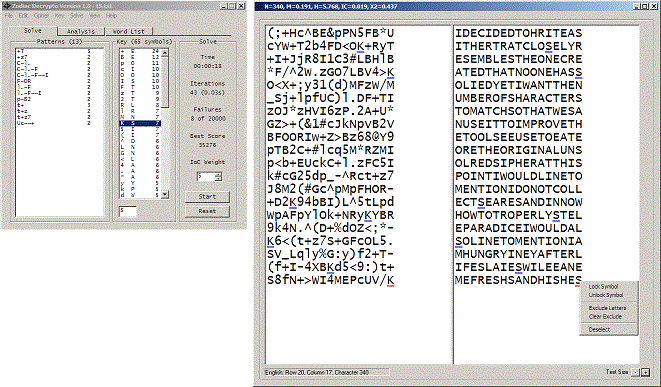HistoCrypt 2019, an annual conference on historical cryptology, convenes this week. The proceedings have been published and include many fascinating papers:
http://www.ep.liu.se/ecp/158/ecp19158.pdf
Those here who like to tinker with solvers and the Zodiac ciphers need to read these:
Nils Kopal, "Cryptanalysis of Homophonic Substitution Ciphers Using Simulated Annealing with Fixed Temperature" (This paper in particular is the first to formally acknowledge and accurately describe the long-available solvers such as ZKDecrypto and AZDecrypt)
Tom S Juzek, "Using the Entropy of N-Grams to Evaluate the Authenticity of Substitution Ciphers and Z340 in Particular" Notable conclusion:
We applied those two SVM models to the the Zodiac Killer’s two major ciphers, z408 and z340. z408, which has been solved, is correctly predicted to be a real substitution cipher. z340, which remains unsolved, is predicted to not be a substitution cipher. We think that it is likely that z340 is either another type of cipher, e.g. a transpose cipher or a Vigenere cipher, or that it might not be a bona fide substitution cipher after all.
Also, while this one is about PlayFair ciphers, the algorithmic techniques described in the paper would well apply to homophonic solvers:
George Lasry, "Solving a 40-Letter Playfair Challenge with CrypTool 2"
The proceedings are definitely worth a read if you have any technical interest in cryptology in general and the Zodiac ciphers in particular!
Thanks for sharing doranchak.
Massive pdf, great stuff!
I also like this: The DECODE Database Collection of Historical Ciphers and Keys
I’ve just thanked Nils in an e-mail for reviewing AZdecrypt.
As a reminder, Largo’s solver The Raccoon (included with Peek-a-boo 1.0) is also out there but was not included in the paper.
Thanks Doranchak for sharing these.
I’ve had a similar idea to use SVM’s to classify ciphertexts but have never gotten around to implementing it.
Well, that Kopal paper certainly gives short shrift to ZKDecrypto. I found it easily solved that example cipher in 18 seconds. As well, ZKD is fully interactive and allows locking letters (using right-click) and also excluding letters from any symbol, exactly as he describes his program doing. All of these features have been included since the very first beta releases.
I wonder if he even looked at the program for more than a minute, sigh…
-glurk
——————————–
I don’t believe in monsters.
Well, that Kopal paper certainly gives short shrift to ZKDecrypto.
I agree.
ZKDecrypto was the first of its kind and I used its core ideas to create AZdecrypt.

